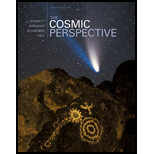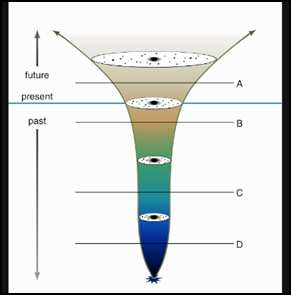
Concept explainers
To explain:
The expansion of the universe accelerating, casting or decelerating at point A.
Answer to Problem 1VSC
Solution:
At the point A, the expansion of the universe is accelerating.
Explanation of Solution
Introduction:
The expansion of the universe happens with the change in the time. The distance between two points increases. This is due to the expansion of space-time. The scale of space-time fabric itself changes. This expansion is given by four models namely, re-collapsing universe, critical universe, coasting universe, and accelerating universe as shown in the figure.

Point A is a time in future. At point A, the expansion of the universe is accelerating. The two distant points in the universe would be moving farther apart. The scale of the space-time fabric was expanding. The galaxies would be moving apart more rapidly. The gravitational force would not be strong enough to decelerate or stop expansion.
Conclusion:
Point A represents the accelerated expansion of universe in future.
Want to see more full solutions like this?
Chapter 23 Solutions
The Cosmic Perspective
- When current is flowing through the coil, the direction of the torque can be thought of in two ways. Either as the result of the forces on current carrying wires, or as a magnetic dipole moment trying to line up with an external field (e.g. like a compass). Note: the magnetic moment of a coil points in the direction of the coil's magnetic field at the center of the coil. d) Forces: We can consider the left-most piece of the loop (labeled ○) as a short segment of straight wire carrying current directly out of the page at us. Similarly, we can consider the right-most piece of the loop (labeled ) as a short segment straight wire carrying current directly into the page, away from us. Add to the picture below the two forces due to the external magnetic field acting on these two segments. Then describe how these two forces give a torque and determine if the torque acts to rotate the loop clockwise or counterclockwise according to this picture? Barrow_forwardIn each of the following, solve the problem stated. Express your answers in three significant figures. No unit is considered incorrect. 1. For the circuit shown, determine all the currents in each branch using Kirchhoff's Laws. (3 points) 6 5V 2 B C 4 A www 6 VT ww T10 V F E 2. Compute for the total power dissipation of the circuit in previous item. (1 point) 3. Use Maxwell's Mesh to find Ix and VAB for the circuit shown. (3 points) Ix 50 V 20 ww 21x B 4. Calculate all the currents in each branch using Maxwell's Mesh for the circuit shown. (3 points) www 5ი 10 24V 2A 2002 36Varrow_forwardIf the mass of substance (1 kg), initial temperature (125˚C), the final temperature (175˚C) and the total volume of a closed container (1 m3) remains constant in two experiments, but one experiment is done with water ( ) and the other is done with nitrogen ( ). What is the difference in the change in pressure between water and nitrogen?arrow_forward
- Using the simplified energy balance in Equation 1, suppose there is heat transfer of 40.00 J to a system, while the system does 10.00 J of work. Later, there is heat transfer of 25.00 J out of the system while 4.00 J of work is done on the system. What is the net change in internal energy of the system?arrow_forwardYou pour a litre (1 kg) of 25.0˚C water into a 0.500 kg aluminium pan off the stove, but has previously been heated so it starts with a temperature of 120˚C. What is the temperature when the water and the pan reach thermal equilibrium (i.e., what is the temperature of both objects when they reach the same temperature)? Assume that the pan is placed on an insulated pad and a negligible amount of water boils off.arrow_forwardA golf club hits a golf ball and the golf ball’s flight reaches a maximum height of 5.48 m. Calculate the momentum of the golf ball at the maximum height if the mass of the golf ball is 0.459 kg.arrow_forward
- • Superposition Theorem • Thevenin's and Norton's Theorem 1. Find the unknown voltage V₁, unknown resistances R1 and R2, and currents flowing through R1 and R2 for the circuit shown below using Superposition Theorem. 40 V + R₁₂ w B C ♥16A 10A www 4A F ww 2 E Ꭰ 2. Use Thevenin's Theorem to find the current flowing in 3-ohm resistor and its power dissipation from the circuit shown in the right. + 3. Use Norton's Theorem for the same instruction as for No. 2. 8 V A www 202 B wwww 20 Ω 10 V + 302 202 www C - 12 V 502 www.arrow_forwardFill in blanksarrow_forwardA rock is dropped from a height of 2.00 m. Determine the velocity of the rock just before it hits the ground. If the momentum of the rock just before hitting the ground is 14.0 kg m/s, what is the mass of the rock? Is the collision between the rock and the ground elastic or inelastic? Explain.arrow_forward
- Describe how the momentum of a single ball changes as it free falls from a height of approximately 1 m, collides with a hard floor, and rebounds.arrow_forward• Nature of Resistance Temperature-Resistance Relationship Ohm's Law, Energy and Power Kirchhoff's Law • • Maxwell's Mesh Analysis 1. The steel of the third rail of a railway system has a resistivity of 21.4 μ-cm. If its cross-sectional area is 8.2 in², calculate the resistance per mile of rail, neglecting the effect of joints between sections. (1 point) 2. An incandescent lamp has a tungsten filament whose resistance is 96 at its operating temperature of 2900°C. Calculate the filament resistance when the lamp is disconnected from the electric source, under which condition its temperature is 24°C. (Use do = 0.0045 02/°C for tungsten) (1 point) 3. For the circuit shown, find the following: 50 V 602 10 V 702 a. the value of resistor R. (1 point) b. the equivalent resistance with respect to the 50-V source. (1 point) 4. For the circuit shown, determine all the currents in each branch using Kirchhoff's Laws. (3 points) A 5V 2 В -ний C 4 6 VT ww F E 5. Use Maxwell's Mesh to find I, and VAB…arrow_forwardFor items 8-9, refer to the problem below. Find all the currents flowing in every resistor, power dissipation in every resistor and the total power of the circuit shown at the right using... 8. Kirchhoff's Laws (5 pts) 9. Maxwell's Mesh Analysis (5 pts) A 8 V 10 V B + 20 Ω 3Ω 202 wwww C wwww 202 + 50 www 12 Varrow_forward
 College PhysicsPhysicsISBN:9781305952300Author:Raymond A. Serway, Chris VuillePublisher:Cengage Learning
College PhysicsPhysicsISBN:9781305952300Author:Raymond A. Serway, Chris VuillePublisher:Cengage Learning University Physics (14th Edition)PhysicsISBN:9780133969290Author:Hugh D. Young, Roger A. FreedmanPublisher:PEARSON
University Physics (14th Edition)PhysicsISBN:9780133969290Author:Hugh D. Young, Roger A. FreedmanPublisher:PEARSON Introduction To Quantum MechanicsPhysicsISBN:9781107189638Author:Griffiths, David J., Schroeter, Darrell F.Publisher:Cambridge University Press
Introduction To Quantum MechanicsPhysicsISBN:9781107189638Author:Griffiths, David J., Schroeter, Darrell F.Publisher:Cambridge University Press Physics for Scientists and EngineersPhysicsISBN:9781337553278Author:Raymond A. Serway, John W. JewettPublisher:Cengage Learning
Physics for Scientists and EngineersPhysicsISBN:9781337553278Author:Raymond A. Serway, John W. JewettPublisher:Cengage Learning Lecture- Tutorials for Introductory AstronomyPhysicsISBN:9780321820464Author:Edward E. Prather, Tim P. Slater, Jeff P. Adams, Gina BrissendenPublisher:Addison-Wesley
Lecture- Tutorials for Introductory AstronomyPhysicsISBN:9780321820464Author:Edward E. Prather, Tim P. Slater, Jeff P. Adams, Gina BrissendenPublisher:Addison-Wesley College Physics: A Strategic Approach (4th Editio...PhysicsISBN:9780134609034Author:Randall D. Knight (Professor Emeritus), Brian Jones, Stuart FieldPublisher:PEARSON
College Physics: A Strategic Approach (4th Editio...PhysicsISBN:9780134609034Author:Randall D. Knight (Professor Emeritus), Brian Jones, Stuart FieldPublisher:PEARSON





